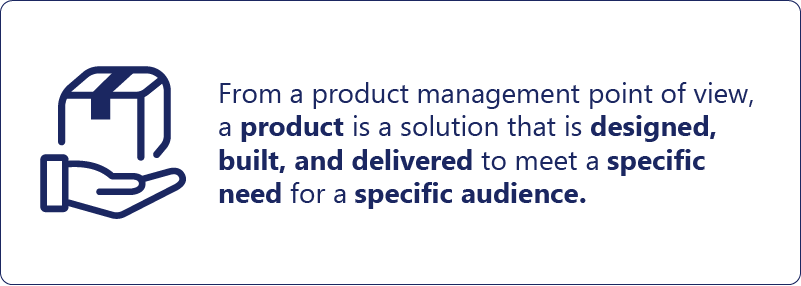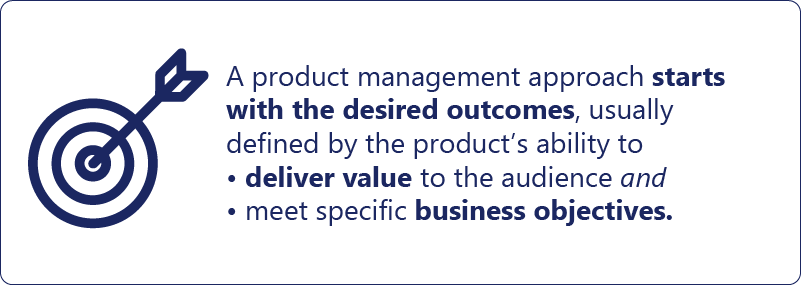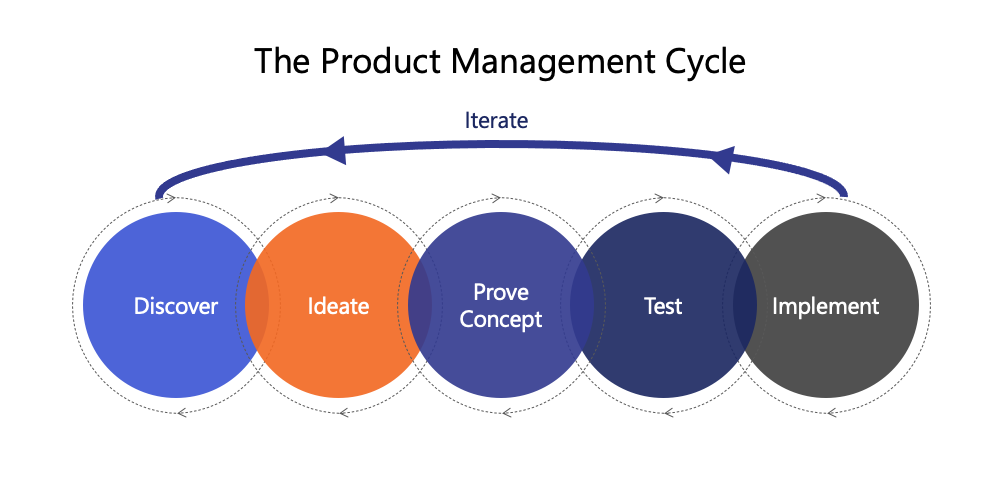6-minute read
Why more businesses are comparing project management vs. product management—and choosing product management for mission-critical deliverables
For decades, businesses have relied on tried-and-true project management in their efforts to build and deliver stuff, whether that stuff is running shoes or a cloud-based software application. And for decades, this approach worked just fine. More recently, an uptick in competitive and budgetary pressures, coupled with an increased need for agility—which the Covid pandemic made painfully obvious—organizations are bumping up against the limits of the project management methodology for certain deliverables. Today’s businesses need a leaner, more flexible, more outcomes-focused option for meeting the needs of their customers, both internal and external. Enter product management.What is a product, anyway?
In decades past, people thought of a product as a physical item that sat on a store shelf, in a warehouse, on a car dealership lot, etc., waiting to be purchased by Joe or Jane Consumer (or, for B2B brands, to be purchased by ABC Company). Even software once required physical media to be delivered to customers (if the phrase “Disk 5 of 22” rings a bell, you remember those days all too well). Today the definition of product has expanded dramatically to include a far broader array of solutions.
From a product management point of view, a product is a solution that is designed, built, and delivered to meet a specific need for a specific audience. The definition still includes physical products, but also extends to digital deliverables and experiences, and to internal audiences as well as external.

Under this definition, products also need not be end-to-end solutions. Your company website and your internal analytics dashboard, for example, are made up of experiences, and each experience can be considered a product in its own right.
Hang on, you might say—in this line of thinking, just about anything could be a product. And you’d be correct, which is why product management can be applied to such a broad range of initiatives.
Project management vs. product management: what’s the difference?
Traditionally, when businesses have been tasked with meeting a need, they’ve approached the undertaking as a project. This entailed figuring out what needed to be delivered, writing requirements, putting together a budget and a timeline, and building a team—then off they went. If the finished product met requirements and was delivered on time and within budget, they chalked it up as a win and went on to the next thing … and if not, well, better luck next time.
So, what happens if nobody uses the product after it launches? What if a competitor launches a similar (but better) product a month later? What if a major event causes a sudden, dramatic shift in audience expectations, as we saw when the Covid pandemic hit? If any one of these situations were to arise, you’d have to start back at Project Management Square One: determine what is needed, write the requirements, reassemble the team members (some of whom may no longer be available), and so on.

While it’s true that “agile project management” has been touted as a solution to these gaps, this has yet to pan out, at least in the way agile has historically been implemented. Fortunately, there’s an approach that delivers on the promises of agile-done-right and then some: product management methodology.
A product management approach starts with the desired outcomes, usually defined by the product’s ability to (a) deliver value to the audience and (b) meet specific business objectives—a sharp contrast to the project management goals of meeting requirements, timelines, and budgets. Much time is spent at the outset analyzing audience needs, market conditions, and potential risks and opportunities. The business then assembles a cross-functional team dedicated to the product and builds a strategy incorporating frequent progress checks and regular iteration releases. This framework stays in place throughout the lifecycle of the product, enabling the product team to respond quickly to changes in audience expectations, the competitive environment, and unforeseen risks and opportunities.

Why product management, and why now?
While the advantages of a product management approach are clear, the concept is not exactly a new one … which begs the question of why so many businesses are just now making the leap from project management vs. product management. We believe it comes down to four factors:
1. Covid: Apologies in advance if you’re tired of hearing about how the coronavirus changed the business world forever … but yeah, it did. The sudden onset of a global pandemic required businesses to pivot on a dime, highlighting the need for agility to be permanently woven into the fabric of every organization. Because the product management approach has the built-in flexibility to adapt quickly as conditions change, it’s a natural fit for today’s business environment.

2. Budgetary pressures: More businesses are adopting lean organization principles and looking to do more with less (or at least more with the same). Product management makes it easier for organizations to connect budgetary outlays with business outcomes, helping to ensure dollars are spent where they can yield the highest return.
3. Competitive pressures: Today’s businesses need to move faster than ever just to maintain their competitive position. Product management not only enables faster go-to-market timelines, but also requires having a continuous finger on the pulse of the market so that risks and opportunities can be identified and addressed as soon as they arise.
4. Greater emphasis on delighting customers: Amazon, Uber, and Netflix have forever changed customers’ expectations for brand experiences across the board—B2B and B2C, internal and external. Whether your product is a new consumer app or an internal analytics platform, people expect experiences optimized just for them, from the very first product touchpoint.
Implementing product management in your organization
Hopefully it’s now clear that product management isn’t an abstract concept or a tweak to managing how things get done—it’s a radically different paradigm that requires a revised way of thinking. High-performing product teams require much more than the combination of technical skills and organizational acumen needed to do the work on time and within budget. They demand an intricate balance of strategic insight, consensus building, expert resource management, data-centric mindset, and a strong sense of market risks and opportunities.
Because it can be a challenging to build the internal structures and teams necessary to implement successful product management, many businesses are recognizing the value of bringing in a trusted partner. Logic20/20 has successfully managed products for multiple clients across industries; if you need resources or some advice to get started, just let us know.
Looking to the future
So what’s the future of the project management vs. product management conundrum? Project management continues to be ingrained in the culture of business, and to be fair, there are still situations where a project management approach is entirely appropriate. But for companies looking to keep up with competitive and budgetary demands and to maintain the agility that success in today’s market requires, product management is the optimal choice for developing, delivering, and iterating on their most mission-critical deliverables.
Like what you see?

Evan Alkhas is a Strategy Manager at Logic20/20 with extensive knowledge in strategic development, operating models, business process optimization, and new product innovation.

